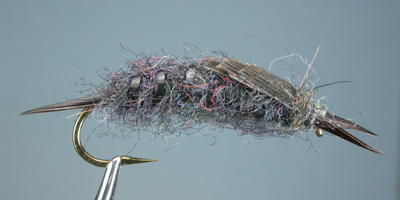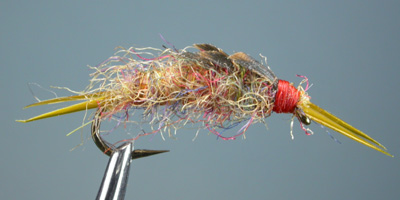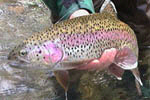|
|
The Flytier:
|
"Originated" By:
Randall Kaufmann
Tied By: C.
Stewart Denton
Story By:
Stew
Stew's Home:
Borger, Texas
Stew's Email: sddenton@sbcglobal.net
|
Stew enjoys tying standard patterns, modifying them
slightly to use what he has on hand or to use materials he
prefers to tie with. He favors natural materials that are
obtained locally; such as quail, pheasant, duck and goose
feathers, and hair from local game animals. Though not
entirely "natural", Stew is excited about the possibilities
offered by the iridescent dubbing he uses in the flies shown
here. |
The Fly:
The
Story:
|
Stew's "Kaufmann Stonefly"
Variations
|
|
I
have done well with the Kaufmann Stone tied with Iridescent Dubbing.
The dubbing has a nice translucent quality, and has several colors
mixed together to give it many tiny different colored points of
light reflection. In my opinion the Iridescent dubbing makes the
pattern far more effective than the goat that is often used. After
tying the stone, I tease out a good bunch along the abdomen. The
dubbing is tough and resists teasing, so I use the point of the
bodkin, and aggressively dig away at it.
I
remember when I tied the first one. I was using goat, and was tying
Kaufmann Black Stone nymphs. It was very late, and I was beat, but
decided to tie one with the Iridescent dubbing anyway. The next
morning I got up and looked at the nymphs. Unlike the previous
evening, in the morning I had good light, and when I put two nymphs
side by side in the sun the difference was like night and day. The
Iridescent dubbed nymph was sparkling and had a translucent look on
the edges, but the goat dubbed nymph looked flat and dead by
comparison. Later when I fished them, it was clear that the
Iridescent Dubbing nymphs look even better when wet than they do
dry.
My
favorite and most productive nymph is a #12 Iridescent Kaufmann
Golden Stone. It has done well for me a lot of times stream fishing.
I fish the Southern Rockies, primarily Northern New Mexico and some
in Southern Colorado. I have tied the golden stone pattern with
mottled turkey wing cases, and also with wing cases of whitish
turkey that is spotted with brown, black, and tan spots. I am not
sure which is more effective.
A friend
has used the same Iridescent Golden Stone in lake fishing. I tie
them for him in #8, as that is the size he really likes. I have no
idea what the trout think they are getting when they take a golden
stone pattern in a lake, but he swears that it has worked great for
him, and it is his favorite nymph.
The
dubbing is available in several colors, but the two I use are the
golden stone and the black stone.
The
dubbing is found in just a few shops. I suggest you
contact Ronn Lucas, the
supplier, by e-mail to find out about
availability.
The
dubbing is best applied with a dubbing loop, as it is pretty coarse
and is a synthetic dubbing. Ronn Lucas has mentioned that it
is a seal substitute.
I tie the Kaufmanns with plenty of
lead wire to weight it, and use appropriately colored yarn as an
underbody and then go over it with an Iridescent Dubbing loop, as
this makes the tying go more quickly.
--Stew Denton
|
Stew's recipe for the "Kaufmann
Black Stonefly Nymph":

Hook: Mustad 9672, Nos. 4-12
Thread:
Black 6/0 Unithread
Weight: Wraps of
lead wire
Tails: Black biots
Rib:
Black vinyl rib
Underbody: Black
yarn
Abdomen: Black Iridescent
dubbing
Wingcase: Fleximent treated turkey tail
tied in three sections
Thorax: Black Iridescent
dubbing
Antennae: Black biots
Tying Tips: (1) The dubbing is best tied with a dubbing loop, as it is pretty
coarse and is a synthetic dubbing. (2) I tie the
Kaufmanns with plenty of lead wire to weight it, and use
appropriately colored yarn as an underbody and then go over it with
the Iridescent in a dubbing loop, as this makes the tying go more
quickly.
|
Stew's recipe
for the "Kaufmann Golden Stonefly Nymph" :

Hook: Mustad 9672, Nos. 6-12
Thread:
Orange (preferred), or tan 6/0 Unithread
Weight:
Wraps of lead wire
Tails: Amber
biots
Rib: Amber vinyl rib
Underbody:
Tan yarn
Abdomen: "Gold Stone"
Iridescent dubbing
Wingcase: Fleximent treated
mottled (or spotted brown and black on white) turkey tied in three
sections
Thorax: "Gold Stone" Iridescent
dubbing
Antennae: Amber biots
Tying Tips: (1) The dubbing is best tied with a dubbing loop, as it is pretty
coarse and is a synthetic dubbing. (2) I tie the
Kaufmanns with plenty of lead wire to weight it, and use
appropriately colored yarn as an underbody and then go over it with
the Iridescent in a dubbing loop, as this makes the tying go more
quickly.
|
Detailed Tying Instructions from Stew:
- (Optional) Bend the hook shank, at a point about one-third to
one-half of the way from the eye of the hook, so that the point of
the hook points to the eye of the hook.
- Lay down a base thread wrap and coat with head cement, let
dry.
- Weight the shank with wraps of lead wire, and over-wrap
with thread.
- Using rabbit dubbing which matches the color of the Iridescent
dubbing, form a ball of dubbing at the end of the shank and tie in
the biots for the tail. The dubbing ball will angle the
biots slightly upward.
- Tie in the vinyl rib at the base of the tail and then form a
tapered under body forward to a point a little longer than one
half the length of the hook shank.
- Form a dubbing loop of Iridescent dubbing and wrap the dubbing
loop forward to form the back half of the body. On the large
nymphs it is often necessary to repeat this step (sometimes twice)
to get good coverage. Use plenty of the Iridescent dubbing, as you
will dig it out aggressively.
- Wrap the ribbing forward to form a segmented look and tie down
the ribbing, trimming of the excess.
- Use a bodkin to aggressively dig out the dubbing to give a
buggy abdomen.
- Form a tapered base for the rear wingcase. I normally use yarn
as an under body, and then use a dubbing loop and plenty of the
Iridescent dubbing.
- Trim a piece of turkey feather to form a "v" shape for the
rear edge of the wingcase and tie in.
- Use more yarn and dubbing to form a second tapered wingcase
base in front of the first wingcase.
- Trim a second piece of turkey feather to form a "v" shape for
the rear edge of the middle wingcase. The middle wingcase should
be a little wider than the rear wingcase. Tie in the wingcase.
- Form a ball of rabbit dubbing at the base of the hook eye, and
tie in the biots to form the antenna.
- Again use more yarn and dubbing to form a third tapered
wingcase base in front of the middle wingcase.
- Trim a third piece of turkey feather, again with a "v" shape
for the rear edge to form the front wingcase. It should be wider
than the middle wingcase. Tie in the front wingcase.
- On the larger sizes, lay down several wraps of dubbed thread
to cover the base of the front wingcase. Omit this step on the
smaller sizes.
- Form a thread head, whip finish, and head cement.
- Again use the bodkin to aggressively dig out the dubbing to
form a very buggy thorax.
|
Comments and tips:
There are several tying steps needed to tie one of these nymphs,
and it is not a quick tie for me. It takes practice to get down the
spacing and shape of the wingcases. However, the trout donít really
care how neat the nymph is. They donít count very well either, so if
you run out of room when tying in the wingcases just tie in two
wingcases.
When tying the nymph, wrap the thread wraps fairly tightly to
keep the body of the nymph firm. The Iridescent dubbing is tough
stuff, and a strong tying thread is needed to hold things together
when you are digging away at the dubbing to form the buggy
appearance. For that reason use tough thread like 6/0 Unithread or
some other strong tying thread.
Finally, the black nymph is normally only tied from # 4 to #8;
however, I use it also to represent the early black stone, and so
also tie the smaller sizes. I have also been tempted to tie it in
#2. The golden stone is normally only tied from #6 to #10, but I use
it to represent smaller brown/dark amber stone nymphs as well, so
also tie the #12. In fact, I have had the best success with the #12
golden stone nymph.
|
|
copyright © Notice by fishingwithflies.com.
All rights reserved. This
material is for your personal enjoyment. Please obtain prior
written permission from the author and fishingwithflies.com
before any other
use. |
| |



